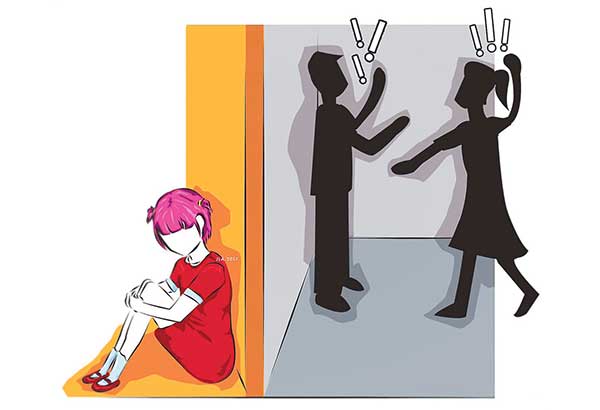Children caught in the crossfire between warring parents


Illustration by JAYMEE L. AMORES
In real life, not all marriages are made in heaven. When parents make the irrevocable decision to part ways, the children, who should greatly matter to them, are the most vulnerable victims.
The effects on children caught in the crossfire of warring, separating parents are as devastating as the effects on children caught in the crossfire of actual war.
There is an urgency in protecting these young victims from their extremely stressful exposure to their parents’ fighting. Why? Because excessive stress in children will disrupt the architecture of the developing brain.
Our capacity to cope with stress is under the control of brain circuits and hormone systems that will respond to adapt to environmental challenges. Whenever threatened, these interrelated systems will signal the brain, which in turn, will trigger the production of brain chemicals and stress hormones so that the individual can adapt to the threat.
When the stress system activates more frequently and for longer periods, then the risk for the development of stress-related physical and mental illness later in life may result.
Healthy brain development can be deflected by prolonged excessive activation of the stress response systems in the body and brain resulting in damaging effects on the child’s future learning, behavior and physical and mental health across the lifespan.
When there is a threat, the body will respond with increase in heart rate, blood pressure and stress hormones like cortisol. When such a threat happens to a child within an environment of supportive relationships with adults, the physiological effects are buffered. This will lead to the development of healthy stress systems needed for survival.
Now if the stress response is extreme and prolonged with no buffering supportive adult relationships, the result is a weakened stress response systems and brain architecture with possible lifelong adverse consequences.
There are three kinds of responses to stress:
1. Positive stress response — This is the normal and basic part of healthy development. The increase in heart and blood pressure is short-lived. For example, this may be seen in the child’s first day with a new nanny.
2. Tolerable stress response — This may result from more severe and longer lasting difficulties like with the death of a significant loved one. If this is time-limited with the presence of a buffering supportive relationship with an adult, the brain and body systems will recover without resulting damaging effects.
3. Toxic stress response — This can happen when a child is exposed to strong, frequent and prolonged difficulties like chronic physical and emotional abuse and domestic violence without adequate buffering adult support. This prolonged activation of the stress response systems will disrupt the healthy development of the brain architecture and the organ systems of the child’s body, thereby increasing the risk for future stress-related diseases and cognitive and psychological impairment.
Adverse childhood experiences will increase the possibility of developmental delays and future health problems, including heart disease, diabetes, depression and substance abuse. Studies have shown that supportive, responsive and nurturing relationships with empathizing adults early in life can prevent or reverse the damaging effects of toxic stress response.
Parents in conflict and their children will benefit from therapy. The parents must be helped to come to the realization that their children matter the most and should not be turned into pawns, forcing them to take sides or to alienate them against the other parent. Children caught in the crossfire have that magical wish that all of their parents’ marital woes will go away. Sadly, in the process, they develop mannerisms and symptoms to deal with the parental conflict. These children are not psychologically prepared to witness the parents’ silent hatred toward each other or hearing their litany of angry words and eventually turning them into “pawns” as a result of the complications of their problematic negotiations. The children will develop more issues as their parents fail to resolve their inner conflicts.
Therapy must center on attempting to resolve the marital conflict or at least attempt to diffuse their intense emotions so they can eventually focus on what should matter the most, the future of their children. The therapist must assist the parents to process and work towards a resolution that can put a stop to the conflict.
As a general rule, children are resilient. They easily learn to cope with situations in the family if they have good role models. Children will develop better coping skills when their parents show their ability to communicate with each other and connect in a positive manner.
However, when children become “pawns” or even “spies,” they learn negative coping skills. They learn to move around this reality of acting as “broker” for their parents by lying and becoming manipulative. When they don’t know anymore what to expect from their parents, they may develop maladaptive behavior or symptoms like anxiety, anger, sadness, oppositional behavior, poor relationships with peers or siblings and even poor academic performance or school refusal. In some cases, these children suffer further when they are bullied in school because of their “broken” family status.
Therapy will assist the warring parents to help them pinpoint their needs and interests. They should be aided and guided to be able to let go of the painful past, diffuse their intense emotions, become positive and focus on their future and also the future needs of their children.
An ally in the therapy for these children caught in the crossfire can be an extended family member like a grandparent, who, in the meantime can provide the supportive buffering adult relationship. Treatment goals for the child should include: promoting healthy relationship with both parents; correcting the child’s cognitive misperceptions; maintaining the child’s balanced view of both parents; improving the child’s judgmental thinking skills; improving the child’s coping skills/resiliency; and boosting the child’s self-esteem. In certain cases, environmental manipulation may be recommended to ensure the safety of the child.
(For questions on love, looks and relationships, you may e-mail me at nina.halilijao@gmail.com. Advanced happy birthday to my granddaughter, Erin Bianca O. Jao!)















